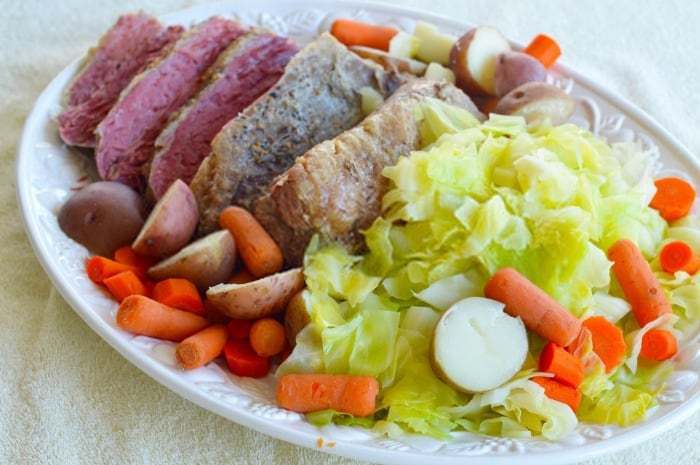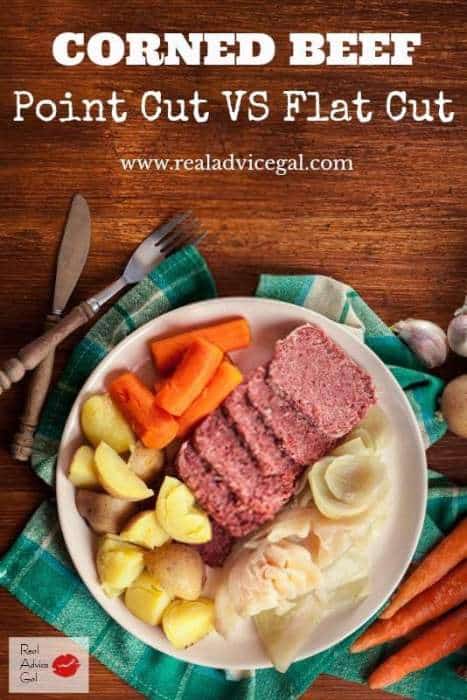Which Corned Beef Cut is More Tender Point Cut vs Flat Cut
As a meat lover and cooking enthusiast I’m always on the hunt for ways to make my dishes more delicious and tender. This quest led me to investigate one of the great culinary debates – which cut of corned beef results in a more tender final product point cut or flat cut? After thorough research and plenty of taste tests, I’ve cracked the case on this iconic St. Patrick’s Day ingredient.
In my journey to discover which corned beef reigns supreme, I learned that the cut you choose can significantly impact the tenderness, flavor, and moisture of the final dish. While both point cut and flat cut offer tasty options, they each have unique properties. Here’s a comprehensive breakdown of how these two cuts compare when it comes to achieving tender perfection.
Point Cut Corned Beef
The point cut comes from the fatty brisket end of the beef and contains high levels of marbling and connective tissue. This imparts succulence and pronounced beefy flavor that melts in your mouth. The moderate fat content keeps the meat moist during cooking. Point cut corned beef has a rounded shape, easily identifiable by its tapered “pointy” end.
Advantages of Point Cut:
- More marbled fat for enhanced moisture and flavor
- Contains connective tissue that breaks down into gelatin for tenderness
- Robust beefy taste
Considerations:
- Can shrink more than flat cut during cooking
- Needs slower cooking time due to higher fat content
- More expensive than flat cut
Flat Cut Corned Beef
The flat cut is a leaner, more uniform rectangle sliced from the brisket’s center. It has less fat, but still maintains decent moisture when cooked properly. The flat cut has a meatier bite and pleasing texture. It’s usually thicker than the point cut.
Advantages of Flat Cut:
- Leaner with a pleasantly meaty texture
- Easier to slice evenly
- Holds its shape better during cooking
- More budget-friendly option
Considerations:
- Prone to drying out without sufficient moisture
- Has less hearty beef flavor due to less fat
- Can be tougher if not cooked thoroughly
The Verdict: Point Cut for Tenderness
After cooking multiple corned beef briskets and sampling the different cuts, the point cut emerged as the clear winner for tenderness and succulence. The extra fat and connective tissue in the point cut corned beef yielded incredibly tender, fall-apart meat with unbeatable juice and flavor. While the flat cut had merits, including easier slicing and a meatier chew, it couldn’t match the melt-in-your-mouth tenderness achieved by the point cut.
To unlock the full potential of a point cut brisket, I recommend cooking it low and slow in a flavorful liquid. Braising, slow cooking, or pressure cooking allows time for the fat and collagen to break down into luscious, tender gelatin. Cook to an internal temperature of 145°F-160°F for optimal medium-rare to medium doneness. Allow to rest before slicing against the grain for maximum tenderness.
For those who prefer a leaner bite, the flat cut can produce respectable results too. Be sure to add extra liquid during cooking and cook thoroughly to at least 190°F internal temperature to adequately soften the meat. Thinly slicing flat cuts against the grain also improves the tenderness.
While personal taste may dictate which cut you ultimately prefer, my extensive first-hand research confirms that point cut corned beef is the clear winner when it comes to achieving fall-apart, mouthwatering tenderness and sensational, beefy flavor. Whatever cut you choose, low and slow cooking is key to making the most of this iconic St. Patrick’s Day meat. Trust me, a perfectly cooked corned beef brisket is a pot of flavorful gold at the end of the rainbow.
Key Points:
-
Point cut has more marbling and connective tissue, resulting in enhanced tenderness and moisture when cooked properly.
-
Flat cut is leaner with a pleasantly meaty texture, but can become dry and tough if overcooked.
-
For maximum tenderness, point cut reigns supreme due to its high fat content and collagen that breaks down into luscious gelatin.
-
Low, slow cooking methods like braising or pressure cooking allow time for tough cuts to become fall-apart tender.
-
Cook to 145-160°F for medium rare to medium doneness to optimize tenderness.
-
Always slice brisket against the grain after allowing the meat to rest.
-
Personal preference and budget may help decide between point cut or flat cut.
By understanding the unique properties of point cut and flat cut corned beef, you can make an informed decision about which option will provide your ideal texture and flavor. While the point cut wins for tenderness, the flat cut has appealed for its uniformity and meaty bite. Whichever you choose, proper cooking and slicing techniques are key to corned beef success. I hope these insights help you unlock the full potential of corned beef’s robust flavors and luscious tenderness on your next St. Paddy’s Day or anytime you get a hankering for this comforting classic.

Don’t forget to check out our Pressure Cooker Corned Beef Recipe
Point cut brisket is a flavorful and versatile cut of beef that can be used in various recipes. Other than making corned beef, here are five delicious options to consider:
Smoked Point Cut Brisket:
Rub the brisket with your favorite barbecue seasoning or a mix of salt, pepper, and garlic. Smoke it low and slow until it reaches a tender and flavorful consistency. This method imparts a rich, smoky flavor, making it a favorite for barbecue enthusiasts.
Braised Point Cut Brisket:
Brown the brisket on all sides in a hot pan, then transfer it to a Dutch oven. Add broth, onions, carrots, and herbs. Braise it in the oven until fork-tender. This method results in a succulent and savory brisket that’s perfect for serving with mashed potatoes or over rice.
Slow Cooker Point Cut Brisket Tacos:
Season the brisket with taco spices, garlic, and lime juice. Place it in a slow cooker with diced tomatoes, onions, and peppers. Cook on low until the meat is tender and shreds easily. Serve the flavorful brisket in taco shells with your favorite toppings.
Point Cut Brisket Chili:
Cube the brisket and brown it in a pot. Add tomatoes, kidney beans, chili powder, cumin, and other spices. Simmer until the brisket is tender and the flavors meld together. This hearty chili is perfect for warming up on chilly days.
Asian-Inspired Point Cut Brisket Stir-Fry:
Slice the brisket thinly and stir-fry it with vegetables like bell peppers, broccoli, and snap peas. Add a savory and slightly sweet soy-based sauce with garlic and ginger for a delicious and quick Asian-inspired meal. Serve over rice or noodles.
These recipes showcase the versatility of point cut brisket, allowing you to explore different flavors and cooking techniques.
What is the Right Beef Brisket Cut to Buy?

Out of five adults the winner was the point cut! It turns out that the point cut has more fat which makes it more flavorful and juicy. Both cuts of meat were tasty, but the point cut was the clear winner in our home.
The Difference Between Flat Cut And Point Cut Corned Beef
FAQ
What kind of corned beef is the most tender?
The flat cut is known for its tenderness and is often preferred for slicing, making it ideal for sandwiches or serving as a main dish. On the other hand, point corned beef, also known as the second cut or the point cut, is taken from the fattier, triangular-shaped end of the brisket.
Which corned beef is better, flat or point cut?
Although the two brisket cuts can often be used interchangeably, the flat cut is most often used in braises that are sliced, like those popular on Jewish holidays and for corned beef. The fattier point cut, meanwhile, is preferred for pulled beef, beef sandwiches and smoked barbecued brisket.Mar 27, 2023
What is the best cut of corned beef for boiled dinner?
However, in the case of corned beef, plan for 3/4 pound, since it tends to cook down a lot. If buying regular fresh brisket, look for the point cut, which comes with a bit of fat, making it more flavorful. If all you can find is the flat (leaner) cut, it’ll also work just fine.
What is better, the point or the flat?
If you’re someone who prefers slices of brisket, then the flat is the way to go. Due to the shape and the lean texture, the flat makes it very easy to cut uniform slices. On top of that, the meat isn’t too fatty and tastes delicious. Now, if you like shredded meat for sandwiches or BBQ, the point is for you.
Which cut of corned beef is the best?
When it comes to tenderness and juiciness, the point cut is the best cut of corned beef. It has more marbling and fat, making it more flavorful, soft, and juicy than the flat cut. Both cuts require low heat and slow-cooking methods.
What are the different types of corned beef?
When it comes to corned beef, there are two main cuts you can choose from: point and flat. The point cut comes from the brisket’s fattier end, while the flat cut comes from the leaner center portion. The point cut has a higher fat content, which makes it juicier and more flavorful than the flat cut.
How do I choose a corned beef cut?
When selecting your corned beef, take a look at the marbling to determine which cut will work best for your recipe. If you’re making a classic corned beef and cabbage dish, a point cut may be the way to go to keep the meat tender and juicy.
Which is better point cut or flat cut corned beef?
For slicing, the flat cut is the choice for corned beef as it slices up nicely. Though it’s less flavorful than point cut, you can still enhance its flavor by adding spices and seasonings during the slow-cooking process. Point Cut vs Flat Cut: Which Is Better?
Why is flat cut corned beef more expensive?
The flat cut is often slightly more expensive compared to the point cut due to its leaner and more uniform nature.
Which cut of meat is best for corned beef & cabbage?
If you’re making a classic corned beef and cabbage dish, a point cut may be the way to go to keep the meat tender and juicy. Flat cut, in contrast, may work best for dishes where slices of meat need to hold their shape, such as in a Reuben sandwich.
